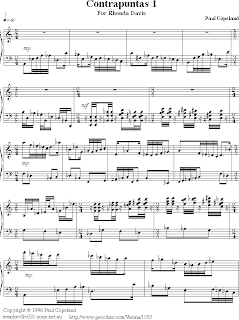Hopefully this works out. I've attached a couple of image files that hopefully my readers can drag to their desktop and print out. What these files are, are sheets that I take to classes and seminars to write down and make a record of what I am learning there.


I've done this for over a year now, conga rhythms and bata. I started off with just the sheets which was very effective, writing down the rhythm's notes, sequence and hand sticking through direct observation of the teacher's demonstration. I now combine this with digital audio recordings I make with my Zoom H2, which is an extremely convenient little device. The two methods, direct observation and the audio recordings, combined with direct experience and memory of playing and hearing the rhythm in class combines to make the most effective and accurate recordings short of video. Many instructors do not permit video recording of classes.
There are several methods of notation that would be suitable for charts like these. I myself use an adaptation of "The "Stoned" Hand-Drum", which is a very cool method itself adapted from the venerable Stone-Stick Control for the Snare Drummer.
The 'Stoned" method uses letters and such for the different tones.
I use a version of this method of letters for the tones of the drums, and I place a letter "R" or "L" for the hand underneath the tone to show the sticking. These methods are similar to tabs for guitar players. Here is an example of one that I have used.
Another method that is very common is to use a row of squares for each hand; dominant hand on top, the other hand on the bottom. Both methods have their advantages. I prefer it written in one row, as I feel it's easier to vocalize the rhythm in one line, the letters end up forming a kind of sentence that I can pronounce.
Writing rhythms for hand drums in standard music notation has one big problem, mainly how to represent the different strokes and the sticking, there has not been a standardized way to represent that in music notation. I often wonder why the different strokes can't be represented on the different lines of the staff, like for a piano. Usually a whole series of little symbols are used, which are always clumsy and differ from book to book. I think you could use a treble clef to represent the higher drums and the bass clef for the lower drum. The note lines would represent the tones, G for slap, E for open tone, B for bass, etc, etc. The sticking would still need to be addressed.
Anyways, it's a debate that is going to go on for a long time: how to transcribe rhythms for hand drums. Hopefully you'll find these little sheets useful, they work well for me. The best way to transcribe them is whatever way works for you best. Of course there is the whole discussion about whether or not rumba and folkloric music which was originally passed down orally can be accurately represented on paper at all, but that's a whole different subject for another post.





Thanks Geordie, the sheets print out fine. Terrific tips and good use of my favorite little recording device.
ReplyDelete